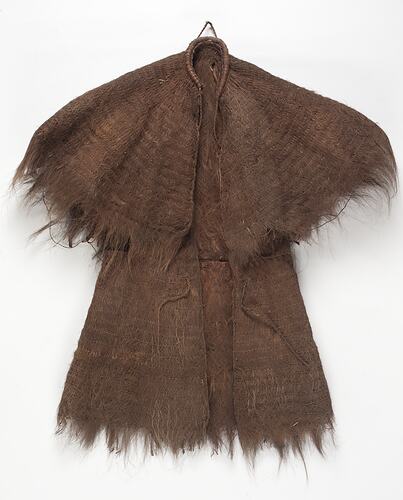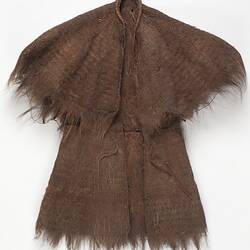Summary
Conservation expertise have assisted in the identification, dating and locating of three items of high significance in Museum Victoria's collections - a Chinese hat, field cape and basket from the nineteenth century.
Within the vast collection of Museum Victoria, three objects - a cape, basket and hat - were believed to be related to Chinese immigration to the Victorian Gold Fields in the 1850s-60s. However no contextual information relating to their provenance accompanied these objects when they were acquired. Undertaken in fulfilment of the University of Melbourne's Master for Cultural Materials Conservation, the research addressed the issue of limited provenance by engaging a focused series of material and technique investigations aimed to shed light on the historic and geographic origin of these objects. This article briefly explains the journey of rediscovering this link.
The Cape
Fibre capes have been traditionally used throughout China, and can be specifically attributed to the rural areas of southern province of Guangdong. The palm sheaths of the Trachycarpus fortunei have been utilised for centuries to make brushes, mattresses, rope and cloaks in this region. A singular comparative analysis of the cellular morphology of the fibre was considered the most effective identification technique and reference sample material was obtained from one of the four Trachycarpus fortunei palms in the Southeast Asian collection at the Royal Botanic Gardens, Melbourne.
Thin cross sections of the fibres viewed under polarised light microscopy permitted the study of diagnostic cellular features. Cape fibres and the reference material exhibited similar shape, diameter and clearly defined vascular tissue regions, however cape fibre samples displayed large empty voids when compared to the dark and densely clustered tissue of the reference material. Fracture and collapse of the cell wall is commonly seen in historic plant artefacts and taking such cellular degradation into account, the fibre of the cape can be positively identified as the Trachycarpus fortunei.
To further inform provenance, these results were integrated with established knowledge of the palm. First noted by Scottish botanist Sir Robert Fortune during the 1850s on an expedition to China, Trachycarpus fortunei seeds were collected and sent to London. While the palm's exact introduction into Australia is unknown it could have only been after this period of time. With the quantity of sheaths required to fabricate the cape only available from mature naturalized palms indicates the cape was constructed in China and most likely in Guangdong.
The Basket
The bundle coil weave is consistent with straw and rattan, both common plant materials used in Chinese basketry. Unfortunately thin cross-section microscopy could not be conducted due to the large sample required and an alternative investigatory pathway was devised.
Utilising reference data from the paper conservation discipline, small fibre samples were collected, macerated and viewed under transmitted and polarised light microscopy. The necessary epidermal cells and metaxylem vessels were difficult to visualise however, the main coil plant element exhibited similarities to rice straw and a tentative identification could be determined.
This investigation revealed the diagnostic value of thin cross section microscopy for plant material identification.
The Hat
Perhaps most interestingly was the correlations between the hat and cape. It is reported that specific provinces produce characteristic ornamentation of hats worn by Chinese labourers working around South-east Asia and further abroad. Elements such as the plaited peak cap, the black lining and gilded paper decoration underneath the lattice frame, are stylistic of hats attributed to the Canton region of Guangdong.
Scientific material investigations were conducted to further support this claim. A multi-method analytical pathway was utilised to investigate the black lining. Fourier transform infrared attenuated total reflectance (FTIR-ATR) analysed the presence of organic molecules in the binder or sizing agent, indicating the possible presence of tung oil, commonly used to treat waterproof paper in Asia. Energy dispersive x-ray fluorescence (ED-XRF) spectroscopy was used to identify presence of inorganic compounds in the composition of the paper's colourant revealing the presence of iron most likely in the form of ferrous ferric oxide, often found in black pigments.
The gilded decorative elements, also examined with ED-XRF revealed a copper-zinc alloy of brass. This result can now inform the future preservation of this object. Copper alloys especially those stamped, rolled or hammered during manufacture, can be highly reactive and susceptible to corrosion becoming embrittled and vulnerable to damage.
The majority of Chinese mining migrants came from the fertile farming plains of the Canton Delta region of Guangdong, the native habitat of the Trachycarpus fortunei and credited province of production for the hat. Therefore, with confidence it can be suggested these objects were brought into Australia during the Gold Rush Era. A timeline of introduction can be estimated as large scale migrations from this region were recorded during the 1850s, the first in 1848. However by 1880 as mining work ceased, such migrations began to decline significantly.
Investigating these objects has harnessed material evidence sufficient to reconstruct a link to the past and the outcomes have augmented curatorial perspectives and an enhanced interpretation of these three objects.
More Information
-
Keywords
-
Authors
-
Article types


